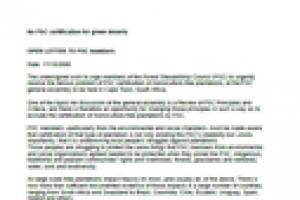United Fiber System's plans to build a pulp empire in Kalimantan received a blow in January 2006, when Deutsche Bank confirmed that it has pulled out of its role as financial advisor to UFS. Five months ago, UFS announced that it had appointed Deutsche Bank's Singapore Branch as Financial Advisor on a proposed acquisition of the Kiani Kertas pulp mill in East Kalimantan.
Michael Hoelz, Deutsche Bank's managing director, confirmed in a statement to German NGOs that "Deutsche Bank no longer holds a mandate with UFS".
Indonesia
Other information
16 December 2005
By Haris Retno Susmiyati
Other information
9 December 2005
Asia Pulp and Paper (APP) is one of the world's largest pulp and paper companies. The company is responsible for large-scale deforestation of Indonesia's forests. APP has also generated a number of not-yet-settled conflicts with local communities in Indonesia.
Forthcoming research by Rully Syumanda, Friends of the Earth Indonesia/WALHI's forest campaigner and Rivani Noor of the Community Alliance for Pulp Paper Advocacy (CAPPA) documents the company's grim record in Sumatra.
Bulletin articles
12 November 2005
The existing Indonesian pulp and paper industry is currently generating a tremendous strain on forests. In that context, a new $1.2 Billion huge pulp and wood chip mill is planned to be built in the province of South Kalimantan.
The project is owned by the company “United Fiber System (UFS)” which is owned, among others, by Swedish capital investors. The new pulp mill would worsen the current depletion of forests in Indonesia, and the national and local problems connected to it.
Bulletin articles
12 October 2005
Local conversations about the classification of the Mount Merapi forest area into a national park often end up questioning why it was established as a park at all.
Mount Merapi forest ecosystem is located at 600 to 2968 meter above sea level, in Yogyakarta Province, Republic of Indonesia. With an area of 8,655 hectares, it is mostly covered by mountain tropical forest which is the source of living of a million people in four districts.
Other information
13 September 2005
Jakarta, we have a problem!
Bulletin articles
14 August 2005
Indonesia’s forests are once again on fire. Smoke from fires in Sumatra caused the worst haze conditions in Malaysia since 1997. An unhealthy smoky haze (a mixture of dust, ash, sulfur dioxide and carbon dioxide) has been covering Malaysia's main city Kuala Lumpur and 32 other towns. Schools were closed, and hospitals filled with patients complaining of respiratory ailments. Data from Indonesia’s Riau Health Service reported that more than 1990 people have been experiencing upper respiratory infection and eye problems.
Other information
14 August 2005
In 1999, the World Bank's Economics of Industrial Pollution Control research team published a report titled "Greening Industry". The report, which was the result of "six years of research, policy experiments, and firsthand observation", described Asia Pulp and Paper's PT Indah Kiat Pulp and Paper as a "success story".
Bulletin articles
14 July 2005
Wonosobo is a rural district in Central Java, close to the mountainous Dieng plateau. Much of its 18,896 hectares of state forest is designated Protection Forest as the hilly uplands are the watershed for several major rivers. Like all other forest land in Java, the Wonosobo forest was controlled by the state-owned forestry company Perum Perhutani, which according to field reports has severely damaged or destroyed well over half the 'state forest'.
Bulletin articles
20 April 2005
Indonesia has the third most extensive area of tropical forest on earth and is one of its richest centres of biodiversity. It is also the world's second largest palm oil producer with an output of over 11 million tonnes of Crude Palm Oil (CPO) in 2004. With Indonesia’s forests disappearing at 3.8 million hectares per year, the land area converted to oil palm plantations has doubled during the past decade to nearly 5 million ha - an area roughly the size of Costa Rica. Most oil palm plantations in Indonesia are established on land which was, until very recently, mature rainforest.
Bulletin articles
27 October 2004
In the Banten region of western Java, Indonesia, exists a small-scale indigenous community that has to a large extent been able to avoid the advancement of globalization, modern technology and other influences of the outside world, including environmental degradation. The Baduy people are a reclusive tribal group that has lived a relatively undisturbed, traditional lifestyle in a closed society for more than 400 years until the recent encroachment of economic and social pressures from the outside world.
Bulletin articles
27 September 2004
Indonesian Law No. 14/1999 bans open-pit mining activities in protected forests and prompts several mining companies to suspend their operations. In July, the Indonesian Parliament endorsed a Presidential decree to amend this law (Perpu No. 1/2004), which stipulates that all mining contracts signed before Law No. 41/1999 on forestry came into effect are valid for the remainder of their terms. The decree provides political justification for 13 mining companies to operate in protected forests. This is the point of entry for a process of destruction in the days to come.

